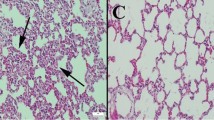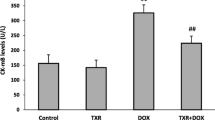Abstract
Introduction
Dexrazoxane (Dex), used clinically to protect against anthracycline-induced cardiotoxicity, possesses iron-chelating properties. The present study was designed to examine whether Dex could inhibit the ischemia/reperfusion (I/R) induced damage to the rat heart.
Materials and methods
Isolated perfused rat hearts were exposed to global ischemia (37°C) and 60 min reperfusion. Dex was perfused for 10 min prior to the ischemia, or administered intraperitoneally (150 mg) 30 min prior to anesthesia of the rats. I/R caused a significant hemodynamic function decline in control hearts during the reperfusion (e.g., the work index LVDP X HR declined to 42.7±10%). Dex (200 μM) applied during the preischemia significantly increased the hemodynamic recovery following reperfusion (LVDP X HR recovered to 55.7±8.8%, p<0.05 vs. control). Intraperitoneal Dex, too, significantly increased the hemodynamic recovery of the reperfused hearts. I/R caused an increase in oxidation of cytosolic proteins, while Dex decreased this oxidation.
Discussion
The decrease in proteins carbonylation and correlative hemodynamic improvement suggests that Dex decreases I/R free radical formation and reperfusion injury.
Similar content being viewed by others
References
Chevion M. A site-specific mechanism for free radical induced biological damage: the essential role of redox-active transition metals. Free Radic Biol Med 1988;5(1):27–37.
Lesnefsky EJ. Reduction of infarct size by cell-permeable oxygen metabolite scavengers. Free Radic Biol Med 1992;12(5):429–46.
Rowley DA, Halliwell B. Formation of hydroxyl radicals from NADH and NADPH in the presence of copper salts. J Inorg Biochem 1985;23(2):103–8.
Kurz T, Gustafsson B, Brunk UT. Intralysosomal iron chelation protects against oxidative stress-induced cellular damage. FEBS J 2006;273(13):3106–17.
Aust SD, Morehouse LA, Thomas CE. Role of metals in oxygen radical reactions. J Free Radic Biol Med 1985;1(1):3–25.
Bernier M, Hearse DJ, Manning AS. Reperfusion-induced arrhythmias and oxygen-derived free radicals. Studies with “anti-free radical” interventions and a free radical-generating system in the isolated perfused rat heart. Circ Res 1986;58(3):331–40.
Powell SR, Hall D, Shih A. Copper loading of hearts increases postischemic reperfusion injury. Circ Res 1991;69(3):881–5.
Doroshow JH. Effect of anthracycline antibiotics on oxygen radical formation in rat heart. Cancer Res 1983;43(2):460–72.
Myers C. The role of iron in doxorubicin-induced cardiomyopathy. Semin Oncol 1998;25(4) Suppl 10:10–4.
Herman EH, Ferrans VJ. Reduction of chronic doxorubicin cardiotoxicity in dogs by pretreatment with (+/−)-1,2-bis(3,5-dioxopiperazinyl-1-yl)propane (ICRF-187). Cancer Res 1981;41(9) Pt 1:3436–40.
Hasinoff BB. Chemistry of dexrazoxane and analogues. Semin Oncol 1998;25(4) Suppl 10:3–9.
Hasinoff BB. Pharmacodynamics of the hydrolysis-activation of the cardioprotective agent (+)-1,2-bis(3,5-dioxopiperazinyl-1-yl)propane. J Pharm Sci 1994;83(1):64–7.
Hasinoff BB. Dexrazoxane (ICRF-187) protects cardiac myocytes against hypoxia-reoxygenation damage. Cardiovasc Toxicol 2002;2(2):111–8.
Hasinoff BB, Schnabl KL, Marusak RA, Patel D, Huebner E. Dexrazoxane (ICRF-187) protects cardiac myocytes against doxorubicin by preventing damage to mitochondria. Cardiovasc Toxicol 2003;3(2):89–99.
Shacter E. Protein oxidative damage. Methods Enzymol 2000;319:428–36.
Khaliulin I, Schneider A, Houminer E, Borman JB, Schwalb H. Apomorphine prevents myocardial ischemia/reperfusion-induced oxidative stress in the rat heart. Free Radic Biol Med 2004;37(7):969–76.
Dalle-Donne I, Rossi R, Giustarini D, Milzani A, Colombo R. Protein carbonyl groups as biomarkers of oxidative stress. Clin Chim Acta 2003;329(1)–2:23–38.
Cvetkovic RS, Scott LJ. Dexrazoxane: a review of its use for cardioprotection during anthracycline chemotherapy. Drugs 2005;65(7):1005–24.
El Hage AN, Herman EH, Ferrans VJ. Examination of the protective effect of ICRF-187 and dimethyl sulfoxide against acetaminophen-induced hepatotoxicity in Syrian golden hamsters. Toxicology 1983;28(4):295–303.
Flandina C, Sanguedolce R, Rausa L, D’Alessandro N. Ameliorative effects of ICRF-187 [(+)-1,2-bis(3,5-dioxopiperazinyl-1-yl)propane] on the cardiotoxicity induced by doxorubicin or by isoproterenol in the mouse. Res Commun Chem Pathol Pharmacol 1990;70(3):259–72.
Fukuda Y, Herman EH, Ferrans VJ. Effect of ICRF-187 on the pulmonary damage induced by hyperoxia in the rat. Toxicology 1992;74(2)–3:185–202.
Plande J, Platel D, Tariosse L, Robert J. Experimental study of dexrazoxane–anthracycline combinations using the model of isolated perfused rat heart. Toxicol Lett 2006;161(1):37–42.
Hess ML, Manson NH. Molecular oxygen: friend and foe. The role of the oxygen free radical system in the calcium paradox, the oxygen paradox and ischemia/reperfusion injury. J Mol Cell Cardiol 1984;16(11):969–85.
Powell SR, Wang P, Katzeff H, Shringarpure R, Teoh C, Khaliulin I, Das DK, Davies KJ, Schwalb H. Oxidized and ubiquitinated proteins may predict recovery of postischemic cardiac function: essential role of the proteasome. Antioxid Redox Signal 2005;7(5–6):538–46.
Paradies G, Petrosillo G, Pistolese M, Di Venosa N, Serena D, Ruggiero FM. Lipid peroxidation and alterations to oxidative metabolism in mitochondria isolated from rat heart subjected to ischemia and reperfusion. Free Radic Biol Med 1999;27(1–2):42–50.
Berlett BS, Stadtman ER. Protein oxidation in aging, disease, and oxidative stress. J Biol Chem 1997;272(33):20313–6.
Esterbauer H, Schaur RJ, Zollner H. Chemistry and biochemistry of 4-hydroxynonenal, malonaldehyde and related aldehydes. Free Radic Biol Med 1991;11(1):81–128.
Kristal BS, Yu BP. An emerging hypothesis: synergistic induction of aging by free radicals and Maillard reactions. J Gerontol 1992;47(4):B107–14.
Schwalb H, Olivson A, Li J, Houminer E, Wahezi SE, Opie LH, Maulik D, Borman JB, Powell SR. Nicorandil decreases postischemic actin oxidation. Free Radic Biol Med 2001; 31(5):607–614.
Khaliulin I, Schwalb H, Wang P, Houminer E, Grinberg L, Katzeff H, Borman JB, Powell SR. Preconditioning improves postischemic mitochondrial function and diminishes oxidation of mitochondrial proteins. Free Radic Biol Med 2004; 37(1):1–9.
Hochster H, Liebes L, Wadler S, Oratz R, Wernz JC, Meyers M, Green M, Blum RH, Speyer JL. Pharmacokinetics of the cardioprotector ADR-529 (ICRF-187) in escalating doses combined with fixed-dose doxorubicin. J Natl Cancer Inst 1992; 84(22):1725–1730.
Herman EH, Zhang J, Rifai N, Lipshultz SE, Hasinoff BB, Chadwick DP, Knapton A, Chai J, Ferrans VJ. The use of serum levels of cardiac troponin T to compare the protective activity of dexrazoxane against doxorubicin- and mitoxantrone-induced cardiotoxicity. Cancer Chemother Pharmacol 2001; 48(4):297–304.
Berenshtein E, Mayer B, Goldberg C, Kitrossky N, Chevion M. Patterns of mobilization of copper and iron following myocardial ischemia: possible predictive criteria for tissue injury. J Mol Cell Cardiol 1997; 29(11):3025–3034.
McCord JM. Oxygen-derived free radicals in postischemic tissue injury. N Engl J Med 1985; 312(3):159–163.
Tenopoulou M, Doulias PT, Barbouti A, Brunk U, Galaris D. Role of compartmentalized redox-active iron in hydrogen peroxide-induced DNA damage and apoptosis. Biochem J 2005; 387(Pt 3):703–710.
Swain SM, Whaley FS, Gerber MC, Weisberg S, York M, Spicer D, Jones SE, Wadler S, Desai A, Vogel C, Speyer J, Mittelman A, Reddy S, Pendergrass K, Velez-Garcia E, Ewer MS, Bianchine JR, Gams RA. Cardioprotection with dexrazoxane for doxorubicin-containing therapy in advanced breast cancer. J Clin Oncol 1997; 15(4):1318–1332.
Lopez M, Vici P, Di Lauro K, Conti F, Paoletti G, Ferraironi A, Sciuto R, Giannarelli D, Maini CL. Randomized prospective clinical trial of high-dose epirubicin and dexrazoxane in patients with advanced breast cancer and soft tissue sarcomas. J Clin Oncol 1998; 16(1):86–92.
Author information
Authors and Affiliations
Corresponding author
Additional information
Eyal Ramu and Amit Korach contributed equally to this study.
Rights and permissions
About this article
Cite this article
Ramu, E., Korach, A., Houminer, E. et al. Dexrazoxane Prevents Myocardial Ischemia/Reperfusion-Induced Oxidative Stress in the Rat Heart. Cardiovasc Drugs Ther 20, 343–348 (2006). https://doi.org/10.1007/s10557-006-0497-4
Published:
Issue Date:
DOI: https://doi.org/10.1007/s10557-006-0497-4




